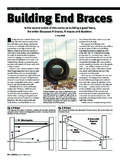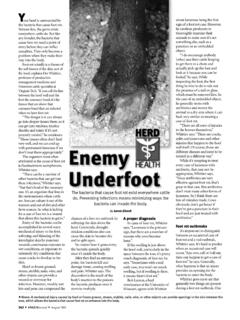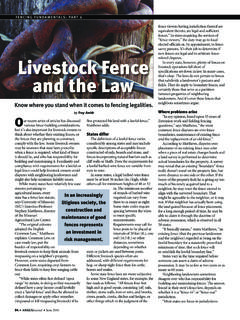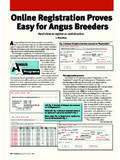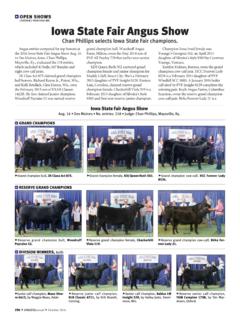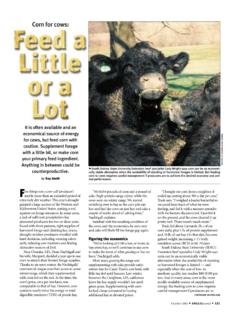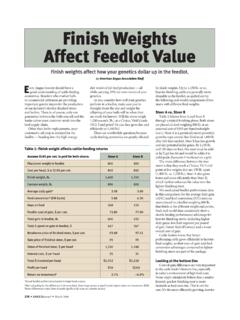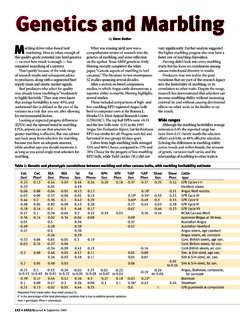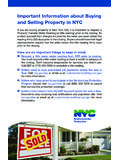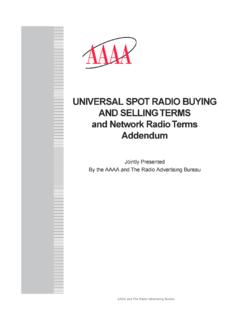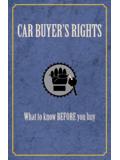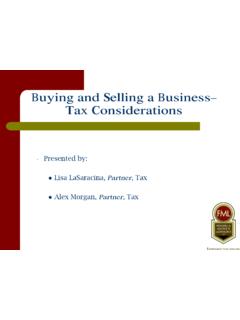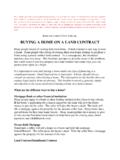Transcription of Buying Breeding Stock? - Angus Journal
1 102nANGUSJ ournalnFebruary 2004 Angus producers who plan to purchase Breeding stock maywant to review currentdepreciation rules with a taxadvisor first. Recent changes indepreciation rates and limits maymake those purchases ultimatelyeasier on the wallet. The changes in depreciation sofar appear to have had a significantimpact on such items as grain binsand livestock equipment, but theymay also have an impact onlivestock, says Neil Harl, IowaState University (ISU) lawyer andeconomist. The cattle business has been sogood, it is hard to say with any accuracy howmuch difference the depreciation changeshave had on purchases.
2 The Jobs and Growth Tax ReliefReconciliation Act of 2003, which wasenacted at the end of May 2003, may offerproducers some incentive for makingbreeding stock purchases both this year andnext. The federal legislation, among otherthings, temporarily increases InternalRevenue Code Section 179 (expense methoddepreciation) amounts and phaseout also provides for an increase in the bonusdepreciation rate from 30% to 50%. Betweenthe two, tax experts say producers may beable to write off more than half of the price ofpurchases in the year of method depreciationIn the case of expense methoddepreciation, the depreciable amount allowedby the Internal Revenue Service (IRS) wasincreased from $25,000 to $100,000 per adjustment covers eligible, depreciableproperty in 2003, 2004 and 2005.
3 You can write off up to $100,000 of thedepreciable cost of your total purchases,provided the total of all eligible depreciableproperty purchased during the year does notexceed $400,000, Harl explains. Above$400,000, the write-off phases out dollar fordollar. Harl explains that according to theInternal Revenue Code Section 1245, newand used property not acquired from arelated person is eligible for expense methoddepreciation. Buildings are excluded, butpurchased Breeding livestock, machinery,equipment, fences and more are eligible. Headds that for a landlord to benefit fromexpense method depreciation, the personmust be meaningfully participating in anyshare-rent lease.
4 Cash-rent leases are notconsidered a business, which is requiredunder expense method depreciation. Breeding females and bulls areconsidered five-year property fordepreciation purposes, Harl says. Theexpanded limit for expense methoddepreciation remains in effect through 2005,and will revert back to $25,000 in 2006without further action. Bonus depreciationBonus depreciation, on the other hand,includes only new, eligible property with nolimit on amount or timing of the ,bonus depreciation can only beused after expense method, if any, has depreciation of 30% was firstintroduced for new, eligible propertyacquired after Sept.
5 10, 2001, as a way to helpjump-start the economy. The bonusdepreciation allowance was increased in the2003 tax bill to 50% for new, eligibleproperty acquired after May 5, 2003, and inservice before Jan. 1, 2005. Property does notqualify for 50% bonus depreciation if abinding written sales contract was in effectMay 6, addition to Breeding cattle, eligible five-year property includes pickup trucks andautomobiles used for business. Seven-yearproperty covers machinery and equipment,farm fences and grain bins, while 10-yearproperty includes single-purpose structuressuch as confinement livestock facilities.
6 Alsoeligible is 15-year property, including landimprovements; and 20-yearproperty, which includes farmbuildings. Females are generallyconsidered new property if theyhave not calved. If that test is met,and the females are purchased forbreeding stock, you are eligible for30% bonus depreciation after , 2001, and 50% from May 5,2003, Harl says. Determiningwhen bulls have first been used forbreeding is tougher. We have lessauthority on that ruling, but bullsshould be considered new if theyhave not been used for Breeding . Harl says farmers may claim the 30% or50% on the entire basis.
7 No limit exists forthe amount of bonus depreciation that canbe taken or when the purchase is madeduring the year. If you claim bonusdepreciation, Harl notes, you are alsoshielded from alternative minimum tax(AMT) on that addition, if you trade a female breedinganimal, for example, bonus depreciationwould be claimed on the undepreciatedamount of the animal plus the cash bootpaid, Harl says. When sold at a gain, bonusdepreciation is still subject to recapture asordinary income. If you claim expense and bonusdepreciation, you must claim them in thatorder (expense method first, then bonusdepreciation) before you claim regulardepreciation, Harl says.
8 Of the allowablebonus depreciation, the IRS will assume youclaimed it, unless you elect out. Consider when you buyTo make the most of depreciation,producers should consider the timing ofpurchases. Regular depreciation is subject tothe mid-quarter convention, Harl adds,which means that the depreciation figuresfor the year an item is placed in service willbe lower if more than 40% of the cost of allpurchases of depreciable property is madeduring the last quarter of the year. That would permit only one-eighth of ayear s depreciation the first year rather thanthe usual rule of one-half a year sdepreciation the first year, Harl says.
9 Amounts claimed as expense methoddepreciation may help the taxpayer avoid themid-quarter rule (which allows only one-eighth of a year s depreciation), if theexpense method depreciation is claimed onproperty placed in service during the lastquarter of the year. Producers are encouraged to contact theirown tax advisors for additional depreciationinformation and BreedingStock?Keep depreciationopportunities in Baylor Anderso
